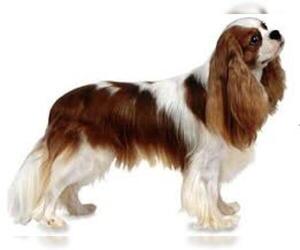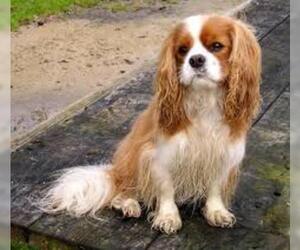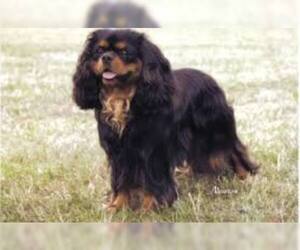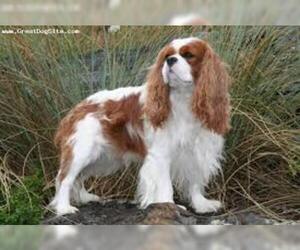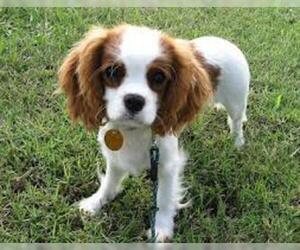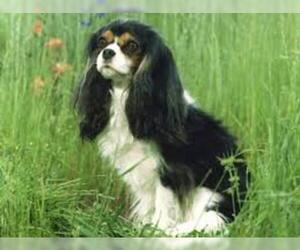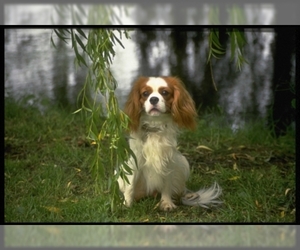
All about Cavalier King Charles Spaniel dog breed
A.K.A. :Cavalier, Cav, CKCS, Royal Spaniel, Toy Cavalier, Cavalier Pup, Velvet Cavalier, Regal Spaniel, British Toy Spaniel, Crown Spaniel, Lap Spaniel, Cavalier Companion, Noble Spaniel, Cavie, Little Royal
Size
Grooming requirements
Exercise requirements
Good with other dogs
Watchdog ability
Energetic
Training requirements
Playful
Affectionate
Good with other pets
Good with children
Good with strangers
Winter
Summer
Healthiness
Protective
Life Span
| Pure Breeds | Member |
| Breeds A - Z | C |
| Breeds by Group | Companion Toy |
| Breeds by Trait | Good With Kids Low Shedding |
| Overview: | The Cavalier King Charles Spaniel is an enchanting toy breed with a rich history, originating from the spaniels depicted in paintings of the 16th to 18th centuries and popularized by King Charles II. They are characterized by their gentle, affectionate temperament, making them exceptional companions. Physically, Cavaliers are small yet sturdy, typically weighing between 13-18 pounds, with a silky, medium-length coat that comes in various color patterns including Blenheim (chestnut and white), tricolor, black and tan, and ruby. Their signature features include a slightly domed head, large expressive eyes, and long feathered ears. Cavaliers are known for being adaptable and eager to please, thriving in both family environments and apartment living due to their moderate exercise needs and loving nature. They generally get along well with children and other pets, fitting seamlessly into most households. However, prospective owners should be aware of certain breed-specific health concerns, such as heart conditions (mitral valve disease) and syringomyelia, making regular veterinary check-ups crucial for their well-being. |
F.A.Q.
All You Need to Know About the Cavalier King Charles Spaniel Breed
The Cavalier King Charles Spaniel is a charming, affectionate toy breed originating from the United Kingdom, renowned for its gentle nature and captivating "melting" expression. These adaptable Cavalier dogs are excellent companions, thriving on human interaction. Physically, they boast a silky, medium-length coat (often tri-color, Blenheim, black and tan, or ruby) and soulful, round eyes. Their temperament is exceptionally sweet, making them ideal family pets and perfect for first-time owners. They get along splendidly with children and other pets, and their small size makes them well-suited for apartment living. Grooming is moderate, requiring regular brushing to prevent mats, while their exercise needs are modest, satisfied with daily walks. Prospective owners should be aware of common health concerns, including heart conditions (Mitral Valve Disease) and Syringomyelia. Overall, the Cavalier King Charles Spaniel is a loving, easily trainable dog that brings immense joy to any home.The average weight for an adult Cavalier King Charles Spaniel is typically between 13 to 18 pounds. While there isn't a significant weight difference between males and females, individual size can vary slightly. Maintaining a healthy weight for your Cavalier King Charles Spaniel is crucial for their well-being.
Cavalier King Charles Spaniel Height: What to Expect
When considering a Cavalier King Charles Spaniel, understanding their typical Cavalier King Charles Spaniel height is important for potential owners. These charming dogs are known for their compact and elegant build.The average height of a Cavalier King Charles Spaniel, measured at the shoulder (or withers), generally falls within a range of 12 to 13 inches. This range applies to fully grown adult Cavaliers.While there isn't a significant difference in how tall is a Cavalier King Charles Spaniel based on gender, male Cavaliers might occasionally reach the slightly higher end of this range, while females might be closer to the lower end. However, individual genetics play a larger role, and some males or females could be slightly outside this typical average size.Remember that these are general guidelines. If you're looking for a Cavalier, reputable breeders can provide more specific information about the lineage and expected adult size of their puppies.The Cavalier King Charles Spaniel colors are officially recognized in four distinct variations by major kennel clubs like the AKC:Officially Recognized Cavalier King Charles Spaniel Colors:* Blenheim: A rich chestnut red on a pearly white background. This is a classic and very popular color.* Tricolor: Jet black and tan markings on a pearly white background. This coat includes tan points over the eyes, on the cheeks, and on the underside of the tail.* Black and Tan: Jet black with bright tan markings above the eyes, on the cheeks, inside the ears, on the chest, legs, and underside of the tail.* Ruby: Whole-colored rich red. This is a solid, unicolored red coat.Rare and Exotic Cavalier King Charles Spaniel Variations (Not AKC Recognized):While not accepted by the AKC or other major kennel clubs for show, some exotic Cavalier King Charles Spaniel variations exist due to genetic combinations, often from unethical breeding practices. These include:* Chocolate (Liver): A brown or liver-colored coat, sometimes with tan points. This is caused by a recessive gene.* Merle: A coat pattern characterized by patches of diluted color and solid color, often with blue eyes. Merle is generally considered an unhealthy gene in Cavaliers and is associated with various health issues.* Blue: A diluted black, appearing as a grayish-blue.* Lilac (Isabella): A very rare dilution of chocolate, appearing as a pale, pinkish-gray.* Cream/Fawn: Lighter variations of ruby or blenheim, sometimes confused with official colors but not recognized if they lack the richness.Potential adopters and buyers should be aware that rare coat types like merle, chocolate, blue, and lilac often command higher prices due to their perceived uniqueness, but they are not AKC recognized Cavalier King Charles Spaniel colors and may come from breeders who do not prioritize health and ethical breeding practices. Focusing on the four recognized colors ensures adherence to breed standards and often better health guarantees.
The Cavalier King Charles Spaniel personality is renowned for its gentle, affectionate, and charming nature. These dogs are true companion animals, thriving on human interaction. Their temperament of Cavalier King Charles Spaniel is typically very friendly, making them excellent family pets. They are loyal and devoted to their owners, often described as "velcro dogs" due to their desire to be close. Highly sociable, Cavaliers generally get along wonderfully with children, displaying patience and a playful spirit. They also tend to be very good with other pets, including cats and other dogs, thanks to their non-aggressive and adaptable disposition. Their moderate energy levels and easygoing nature make them highly adaptable to apartment living, provided they receive regular short walks and mental stimulation. Cavaliers are eager to please, making them relatively easy to train, and their calm demeanor rarely leads to excessive barking.
The Cavalier King Charles Spaniel temperament is known for being exceptionally gentle, affectionate, and eager to please. They are a true companion dog behavior, thriving on human interaction and forming strong bonds with their families. Cavaliers are remarkably friendly and sociable, greeting most people and other animals with a wagging tail. This breed is highly adaptable to apartment living due to their smaller size and relatively low exercise needs, provided they receive daily walks and playtime. They are wonderful with children, displaying patience and a playful spirit, and generally get along very well with other pets, often seeking out their company. While generally biddable, they can exhibit a slight tendency toward stubbornness, particularly during training, but respond best to positive reinforcement and gentle handling as they are quite sensitive. Their sweet, loving disposition makes them an ideal family pet.
Cavalier King Charles Spaniel Care: Daily Maintenance & Health TipsCaring for a Cavalier King Charles Spaniel involves consistent daily maintenance and awareness of their unique needs.Grooming Needs: Cavaliers require regular brushing (2-3 times weekly) to prevent mats and keep their silky coat healthy. Occasional professional grooming may be beneficial. Pay special attention to their wrinkles and ears, cleaning them weekly to prevent infections. Their long, pendulous ears are prone to dirt and moisture buildup.Exercise Limitations: While they enjoy short walks and playtime, Cavaliers are a low-energy dog breed. They adapt well to apartment living but still need daily moderate exercise to stay healthy and happy. Avoid strenuous activity, especially in warm weather.Dietary Considerations: A high-quality diet appropriate for their age and activity level is crucial. Monitor portion sizes closely to prevent obesity, as they are prone to weight gain. Weight management is key to their overall health.Climate Sensitivity: Due to their brachycephalic (short-nosed) anatomy, Cavaliers are highly susceptible to heatstroke. How to care for a Cavalier King Charles Spaniel in warm climates includes keeping them indoors with air conditioning during hot periods and avoiding exercise during peak heat. They also don't tolerate extreme cold well without protective gear.Common Health Concerns: Regular veterinary check-ups are vital. Be proactive about dental care for Cavalier King Charles Spaniel, including daily brushing, as they are prone to dental disease. Watch for skin issues and consult your vet if you notice any irritation or infections. Early detection and prevention are critical for managing breed-specific conditions like heart disease (Mitral Valve Disease) and Syringomyelia.
The Cavalier King Charles Spaniel activity level is generally moderate, making them versatile companions for various households. They are known for their charming blend of short bursts of playful energy and a love for long periods of rest and cuddles. While not a high-energy breed, understanding their specific exercise needs is key to their well-being.
Typically, a Cavalier requires 30-60 minutes of daily exercise, which can be broken into several shorter walks or play sessions. Their exercise needs are easily met with gentle leash walks around the neighborhood, supervised playtime in a securely fenced yard, or indoor games like fetch. They particularly enjoy interactive playtime with their families, thriving on attention and mental stimulation. However, due to their affectionate nature, they are also perfectly content to lounge on the sofa with their humans.It’s important to note the limitations imposed by their brachycephalic (short-nosed) anatomy. Cavaliers can be prone to respiratory issues, especially in hot or humid weather, or during strenuous activity. Therefore, intense or prolonged exercise, particularly in adverse conditions, should be avoided to prevent overheating and breathing difficulties. Always ensure access to fresh water and monitor their breathing during any physical activity. Their ideal playtime preferences lean towards moderate, low-impact activities rather than endurance challenges.How active are Cavalier King Charles Spaniel? They are active enough to enjoy walks and play but also calm enough to be excellent apartment dwellers or companions for less active individuals. They strike a wonderful balance, making them suitable for both families who enjoy moderate daily activities and those in low-energy households seeking a loving, adaptable companion. They are not typically suited for highly active families looking for a running or hiking partner, but they are perfect for those who appreciate a dog that is equally happy playing in the park or napping on a lap.Cavalier King Charles Spaniel Health: What You Should Know
Cavalier King Charles Spaniel health problems are important to understand for any prospective owner. This beloved breed, known for its sweet disposition, has several predispositions to common Cavalier King Charles Spaniel medical issues largely due to their unique anatomy.One significant concern is Brachycephalic Obstructive Airway Syndrome (BOAS). Cavaliers are a brachycephalic (short-nosed) breed, meaning they have flattened faces and often restricted airways. This can lead to breathing difficulties, snoring, and exercise intolerance. Owners should practice brachycephalic dog care by keeping them cool, especially in warm weather, as they are very susceptible to heat sensitivity. Avoid strenuous exercise during hot parts of the day.Another frequent issue is hip dysplasia, a genetic condition affecting the hip joints. Regular veterinary check-ups and a healthy weight can help manage this. Spinal problems, such as syringomyelia, are also common, causing neurological symptoms like neck pain and "phantom scratching."Due to their facial folds, skin fold infections can occur if not kept clean and dry. Regular cleaning is essential. Allergies, both environmental and food-related, are also seen frequently, often manifesting as skin irritation or digestive upset.How to keep Cavalier King Charles Spaniel healthy involves a commitment to preventative care. Regular veterinary visits, a balanced diet, maintaining a healthy weight, and daily grooming (especially around facial folds) are crucial. Be mindful of their exercise levels, particularly in heat, and watch for any signs of breathing difficulty or discomfort. Early detection and management are key to ensuring a long and happy life for your Cavalier.Breed Breakdown: What Experts Say About the Cavalier King Charles Spaniel
I would rate the "Size" trait of the Cavalier King Charles Spaniel a 3 out of 10.Cavalier King Charles Spaniels are undeniably a small breed, fitting comfortably into the toy or small companion dog category. Their average height typically ranges from 12 to 13 inches at the shoulder, and their weight usually falls between 13 and 18 pounds. They possess a compact, well-proportioned body structure that, while not delicate, is certainly not robust or imposing. When compared to other companion breeds, they are considerably smaller than, for example, a Golden Retriever or even a French Bulldog, and are more comparable in size to a Bichon Frise or a Miniature Poodle, though often slightly heavier. This diminutive size makes them exceptionally well-suited for apartment living, as they require minimal space. They are also excellent travel companions, easily fitting into pet carriers for car or air travel, and are ideal for households with space constraints where a larger dog would be impractical.
I would rate the grooming requirements of the Cavalier King Charles Spaniel at a 6.While not as demanding as some long-haired, non-shedding breeds that require professional grooming every 4-6 weeks, the Cavalier is also not a wash-and-go dog. Their silky, medium-length double coat, especially with feathering on the ears, chest, legs, and tail, is prone to tangles and mats if not brushed frequently, ideally every other day or a few times a week. They are moderate to heavy shedder, particularly seasonally, which necessitates regular brushing to manage loose hair around the home. Their long, pendulous ears require weekly cleaning to prevent infections, and nail trims are essential every 2-3 weeks to avoid discomfort and splayed feet. While they don't have extensive skin folds requiring daily care, their long coat can trap dirt, and they are somewhat susceptible to allergies, meaning bathing every 2-4 weeks is generally needed, sometimes with specialized shampoos if skin issues arise. Compared to very short-coated breeds, they require significantly more attention to their coat and ears, making them more high-maintenance than extremely low-maintenance dogs, but still manageable for an owner willing to dedicate consistent time to their upkeep rather than requiring constant professional intervention for complex styling.
I would rate the Exercise Requirements of the Cavalier King Charles Spaniel at a 3.Cavaliers are a relatively low-energy breed, perfectly content with moderate daily activity. Their brachycephalic (short-nosed) anatomy, while generally less severe than some other breeds, does mean they can be prone to overheating and respiratory distress with intense or prolonged exercise, especially in warm weather. They thrive on several short walks throughout the day, perhaps 20-30 minutes each, combined with indoor playtime or a good romp in a securely fenced yard. While they enjoy a game of fetch or chasing toys, they aren't built for strenuous activities like long-distance running or competitive agility, though some can enjoy introductory levels. They are generally adaptable and happy with a flexible routine, making them well-suited for owners who enjoy gentle walks and cuddles rather than marathon training partners. Structured, demanding exercise routines are not necessary for their physical health or mental stimulation; rather, consistent, moderate activity and ample human interaction keep them happy and healthy.
I would rate the Cavalier King Charles Spaniel's "Watchdog Ability" as a 3 out of 10.While Cavaliers are certainly alert to their surroundings and will often bark to signal someone at the door or an unusual sound, their territorial instincts are minimal, and they are overwhelmingly friendly towards strangers. Their barking is more of a "hello, someone's here!" than a deterrent, and they lack the protective drive or size to intimidate an intruder. They are far more of a passive companion, likely to greet an unfamiliar person with tail wags rather than suspicion. They might provide an early auditory warning that *someone* is present, but they are not capable of providing meaningful deterrence or protection in a home environment.
I would rate the Cavalier King Charles Spaniel's "Good with Other Dogs" trait a 9 out of 10.Cavaliers are generally extremely sociable and dog-friendly. Their gentle and affectionate nature extends readily to other canines, making them highly compatible with a wide range of breeds, sizes, and energy levels. They typically greet unfamiliar dogs with curiosity and a wagging tail rather than aggression or dominance. While proper socialization as a puppy is beneficial for any breed, Cavaliers often adapt seamlessly to multi-dog households and thrive in canine company, often seeking out play or companionship from their housemates. They are rarely instigators of conflict and tend to be quite adaptable, often adjusting their play style to suit their canine companions. The need for careful introductions or extensive training to coexist peacefully is usually minimal, as their inherent good nature often shines through.
The Cavalier King Charles Spaniel would rate a 3 on the "Energetic" scale.While they are certainly playful and enjoy a good romp, especially as puppies and young adults, their overall energy level is quite moderate, leaning towards the lower end compared to many other breeds. They are not naturally driven athletes and are generally more laid-back than active. They enjoy daily walks and will happily participate in short bursts of play, but they are equally content cuddling on the couch. Their brachycephalic (short-nosed) anatomy significantly affects their stamina and exercise tolerance. They can easily overheat and struggle with strenuous or prolonged activity, especially in warm weather, making them unsuited for intense outdoor or athletic endeavors. Their need for physical stimulation is met with regular, gentle exercise rather than demanding workouts.
I would rate the training requirements of the Cavalier King Charles Spaniel at a 3.Cavaliers are generally quite intelligent and eager to please, making them relatively easy to train, especially for basic obedience and house-training. They thrive on positive reinforcement and affection, responding very well to gentle praise and treats. While they can have a short attention span if bored, their desire to be with their owner often outweighs any stubbornness, which is typically quite low in this breed. They are responsive to commands and quick to learn routines with consistent, kind handling. This breed is very beginner-friendly and doesn't usually require experienced handling; a loving and consistent approach is far more important than a rigid, highly structured routine. They primarily need a patient owner who is willing to make training a positive and engaging experience.
I'd rate the Cavalier King Charles Spaniel's "Playful" trait a solid 8 out of 10.Cavaliers are a truly delightful blend of affectionate and spirited, making them wonderful companions. They typically possess a moderate activity level that allows them to enjoy a good romp in the yard or a long walk, but they're equally content to curl up on the couch for a nap. Their love for games and interaction is quite strong; they readily engage with their human family in fetch, tug-of-war, or even just a silly chase. They are definitely attention-seeking in a charming way, often nudging a hand for pets or bringing a toy to initiate play. Their response to toys and playtime is enthusiastic, often accompanied by happy tail wags and a bright-eyed eagerness. While not as relentlessly energetic as some terrier breeds, Cavaliers possess an inherent joyfulness and an overall enthusiasm for daily life that consistently shines through. They are naturally spirited and love to be involved in whatever their family is doing, striking a perfect balance between being a playful participant and a relaxed companion.
I would rate the "Affectionate" trait of the Cavalier King Charles Spaniel at a resounding 10. These dogs are the epitome of loving and people-oriented, truly deserving of their "comfort spaniel" nickname. Their desire for human companionship is incredibly strong; they absolutely thrive on being with their family and consider themselves integral members of the pack. Physical closeness is a core part of their nature, with cuddling, lap-sitting, and leaning against their owners being preferred activities. Cavaliers are fiercely loyal and possess a remarkable sensitivity to their owners' emotions, often sensing distress and offering comfort. They are notorious for following family members from room to room, never wanting to be far from the action. Compared to many other companion breeds, the Cavalier King Charles Spaniel is far from independent; they genuinely blossom and are happiest when they are receiving and giving affection, making them a breed that absolutely thrives on it.
I would rate the "Good with Other Pets" trait of the Cavalier King Charles Spaniel at a 9 out of 10.The Cavalier King Charles Spaniel is renowned for its gentle, affectionate, and adaptable nature, which extends remarkably well to other animals. They typically exhibit a very low prey drive, making them generally safe and compatible with cats and smaller animals. Their sweet disposition means they are rarely confrontational with other dogs and often enjoy canine companionship, whether in their own household or during walks and playdates. While resource guarding can occur in any breed, it's not a prominent characteristic in Cavaliers; they are more likely to share or defer than to aggressively guard. They are naturally sociable and possess a strong desire to please, making them highly receptive to training and supervision if minor adjustments are needed to ensure peaceful cohabitation. In multi-pet households, Cavaliers tend to integrate seamlessly, often acting as a calm and friendly presence that helps to diffuse tension and encourage harmony among various species. Their adaptability means they are more likely to thrive than merely tolerate other pets, often forming strong bonds with their animal companions.
I would rate the Cavalier King Charles Spaniel's "Good with Children" trait as a 9 out of 10.This breed is exceptionally child-friendly due to its naturally gentle, affectionate, and patient temperament. Cavaliers are renowned for their sweet and loving disposition, making them very tolerant of the often enthusiastic and sometimes clumsy interactions of children. They generally possess a low prey drive and are not prone to aggression, preferring to be close to their human family members, including the little ones. Their relatively small size makes them less intimidating for younger children, and they are typically quite playful without being overly boisterous. They are also usually quite tolerant of noise and handling, often content to be petted and cuddled. While supervision is always recommended with any dog and child, a Cavalier is more likely to retreat calmly than react negatively, and their inherent good nature means they thrive in a family setting with minimal specialized training beyond basic obedience and socialization. They genuinely enjoy being part of family activities and are wonderful companions for children of all ages.
I would rate the "Good with Strangers" trait of the Cavalier King Charles Spaniel a 9 out of 10.Cavalier King Charles Spaniels are renowned for their incredibly sociable and affectionate nature, extending to unfamiliar adults. They are naturally outgoing and possess a strong desire to be friendly, typically greeting strangers with a wagging tail and an eager lean-in for attention. This breed generally lacks any inclination towards barking or guarding behavior, preferring to welcome newcomers rather than view them with suspicion. Their adaptability in public or guest-filled environments is exceptional; they thrive on being part of the action and are rarely overwhelmed or nervous. While early socialization is always beneficial for any dog, Cavaliers are inherently predisposed to be comfortable and welcoming with strangers, often requiring no specific training to achieve this agreeable disposition.
I would rate the Cavalier King Charles Spaniel's "Winter" tolerance at a 3.While they possess a double coat, it's not particularly dense or long, offering only moderate insulation. Their small size and relatively low body fat make them prone to rapid heat loss. The brachycephalic anatomy, while not as extreme as some breeds, can make breathing more challenging in very cold, dry air, potentially leading to respiratory discomfort. They are at a higher risk of hypothermia in cold conditions, especially if damp or exposed for extended periods. Their ability to safely enjoy outdoor activity in truly cold climates is limited; short bursts are generally acceptable, but prolonged exposure is not advised. Therefore, Cavaliers absolutely require special care during winter months compared to many other companion dogs. They often need sweaters or coats for walks, shorter outdoor excursions, and a warm, draft-free indoor environment to maintain their comfort and health.
I would rate the Cavalier King Charles Spaniel's "Summer" tolerance at a 2.Cavalier King Charles Spaniels are highly sensitive to heat and require significant special care during the summer months, much more so than many other companion dog breeds. Their brachycephalic (short-nosed) anatomy is the primary contributing factor to this low rating. This facial structure severely compromises their ability to effectively cool themselves through panting, which is a dog's primary method of regulating body temperature. They are at a significantly elevated risk of heatstroke, even in moderately warm temperatures or with minimal exertion. Outdoor activity should be strictly limited to very early mornings or late evenings when temperatures are coolest, and even then, only for short periods. They are highly susceptible to overheating and absolutely require access to air conditioning or other forms of climate control during hot weather. Without these precautions, they can quickly succumb to dangerous levels of hyperthermia.
I would rate the Cavalier King Charles Spaniel's "Healthiness" trait as a 4 out of 10.While undoubtedly charming and beloved, the Cavalier King Charles Spaniel is unfortunately plagued by several serious and prevalent genetic health conditions. The most significant concern is Syringomyelia (SM), a neurological condition where fluid-filled cavities form within the spinal cord near the brain, often causing debilitating pain and discomfort. Mitral Valve Disease (MVD) is another widespread issue, affecting a very high percentage of Cavaliers and often leading to heart failure. Other common problems include Chiari-like Malformation (CM), patellar luxation, hip dysplasia, eye conditions, and certain cancers. These predispositions significantly impact their life expectancy, which is generally 10-14 years but can be shortened by the severity of these conditions.Responsible breeding, including MRI screening for SM and regular cardiac evaluations, is crucial to minimize the incidence and severity of these issues, but even with diligent efforts, the breed's genetic load remains substantial. Preventive care is essential, including regular veterinary check-ups to monitor for early signs of MVD and other conditions. Compared to many other companion dogs, Cavaliers are generally considered high-maintenance from a health perspective due to the diligent monitoring, potential for expensive treatments, and the emotional toll of managing these chronic conditions. They are far from generally robust, often requiring a proactive and informed owner to navigate their health challenges.
I would rate the "Protective" trait of the Cavalier King Charles Spaniel as a 2.Cavalier King Charles Spaniels are quintessential companion dogs. They are renowned for their gentle, affectionate, and friendly nature, making them excellent family pets but generally unsuitable for a protective role. Their alertness is moderate; they might bark at a new sound or a person at the door, but this is typically more out of curiosity or a desire to greet than a territorial warning. They have minimal territorial instincts and are usually thrilled to meet strangers, often greeting them with a wagging tail rather than suspicion. While immensely loyal to their owners, this loyalty expresses itself as a desire for companionship and affection, not as a drive to defend. They are too small, non-aggressive, and amiable to be considered watchdogs in the traditional sense, and certainly not guard dogs. Their primary "protection" comes in the form of emotional support and unwavering devotion, not physical defense.
I would rate the "Life Span" trait of the Cavalier King Charles Spaniel as a 4.While Cavaliers can certainly live into their early to mid-teens with excellent care, they are generally considered to be a short-lived to average breed compared to other companion dogs, especially when considering their smaller size which often correlates with longer lifespans. This lower rating is primarily due to the breed's significant predisposition to several serious genetic health issues that can dramatically shorten their lives and impact their quality of life. Mitral Valve Disease (MVD) is incredibly prevalent, with a high percentage of Cavaliers developing it by middle age, often leading to heart failure. Syringomyelia (SM) is another devastating condition affecting a large portion of the breed, causing chronic pain and neurological problems. Other concerns like hip dysplasia, patellar luxation, and certain eye conditions also contribute to potential health complications that can shorten their life expectancy or necessitate difficult management. While responsible breeding and diligent veterinary care can certainly extend and improve the lives of individual Cavaliers, the inherent genetic burden of these prevalent diseases significantly brings down the breed's overall longevity average.
Cavalier King Charles Spaniel Puppies for saleSee all puppies for sale
Cavalier King Charles Spaniel Dogs for adoptionSee all dogs for adoption
Cavalier King Charles Spaniel BreedersSee all breeders
Similar Dog Breeds for Cavalier King Charles Spaniel
Breed Mixes of Cavalier King Charles Spaniel
Quick Breed Selector 0 - not important, 1 - smallest, 10 - largest
Variants & Mistakes :Cavilier King Charles Spaniel, Cavelier King Charles Spaniel, Cavaleir King Charles Spaniel, Cavaliar King Charles Spaniel, Cavalier King Charls Spaniel, Cavalier King Chales Spaniel, Cavalier King Charle Spaniel, Cavalier King Charles Spaneil, Cavalier King Charles Spanial, Cavalier King Charles Spanil, Cavalier King Charles Spaneel, Cavalier King Charles Spaniele, King Charles Cavalier Spaniel, Cavalier King Charles Spiniel, Cavalier King Charles Spianel, Cavalier King Charles Spaneul, Cavalier King Charles Speaniel, Cavalier King Charles Spianle, Cavalier King Charles Spenial, Cavalier King Charles Spanien, Cavalier King Charles Spanele, Cavalier King Charles Spanneil, Cavalier King Charles Spinel
